《定语从句》英语谚语教学提纲
- 格式:docx
- 大小:10.03 KB
- 文档页数:3
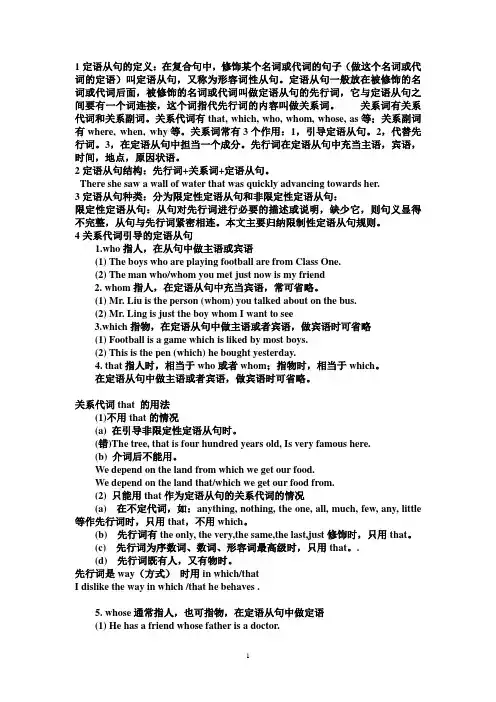
1定语从句的定义:在复合句中,修饰某个名词或代词的句子(做这个名词或代词的定语)叫定语从句,又称为形容词性从句。
定语从句一般放在被修饰的名词或代词后面,被修饰的名词或代词叫做定语从句的先行词,它与定语从句之间要有一个词连接,这个词指代先行词的内容叫做关系词。
关系词有关系代词和关系副词。
关系代词有that, which, who, whom, whose, as等;关系副词有where, when, why等。
关系词常有3个作用:1,引导定语从句。
2,代替先行词。
3,在定语从句中担当一个成分。
先行词在定语从句中充当主语,宾语,时间,地点,原因状语。
2定语从句结构:先行词+关系词+定语从句。
There she saw a wall of water that was quickly advancing towards her.3定语从句种类:分为限定性定语从句和非限定性定语从句:限定性定语从句:从句对先行词进行必要的描述或说明,缺少它,则句义显得不完整,从句与先行词紧密相连。
本文主要归纳限制性定语从句规则。
4关系代词引导的定语从句1.who指人,在从句中做主语或宾语(1) The boys who are playing football are from Class One.(2) The man who/whom you met just now is my friend2. whom指人,在定语从句中充当宾语,常可省略。
(1) Mr. Liu is the person (whom) you talked about on the bus.(2) Mr. Ling is just the boy whom I want to see3.which指物,在定语从句中做主语或者宾语,做宾语时可省略(1) Football is a game which is liked by most boys.(2) This is the pen (which) he bought yesterday.4. that指人时,相当于who或者whom;指物时,相当于which。
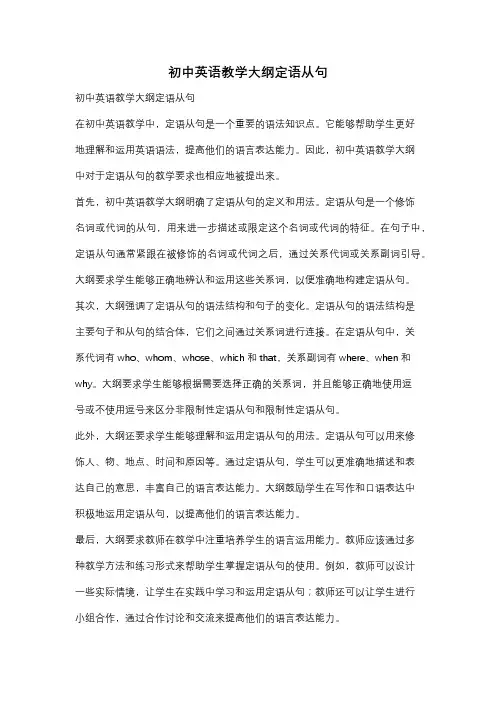
初中英语教学大纲定语从句初中英语教学大纲定语从句在初中英语教学中,定语从句是一个重要的语法知识点。
它能够帮助学生更好地理解和运用英语语法,提高他们的语言表达能力。
因此,初中英语教学大纲中对于定语从句的教学要求也相应地被提出来。
首先,初中英语教学大纲明确了定语从句的定义和用法。
定语从句是一个修饰名词或代词的从句,用来进一步描述或限定这个名词或代词的特征。
在句子中,定语从句通常紧跟在被修饰的名词或代词之后,通过关系代词或关系副词引导。
大纲要求学生能够正确地辨认和运用这些关系词,以便准确地构建定语从句。
其次,大纲强调了定语从句的语法结构和句子的变化。
定语从句的语法结构是主要句子和从句的结合体,它们之间通过关系词进行连接。
在定语从句中,关系代词有who、whom、whose、which和that,关系副词有where、when和why。
大纲要求学生能够根据需要选择正确的关系词,并且能够正确地使用逗号或不使用逗号来区分非限制性定语从句和限制性定语从句。
此外,大纲还要求学生能够理解和运用定语从句的用法。
定语从句可以用来修饰人、物、地点、时间和原因等。
通过定语从句,学生可以更准确地描述和表达自己的意思,丰富自己的语言表达能力。
大纲鼓励学生在写作和口语表达中积极地运用定语从句,以提高他们的语言表达能力。
最后,大纲要求教师在教学中注重培养学生的语言运用能力。
教师应该通过多种教学方法和练习形式来帮助学生掌握定语从句的使用。
例如,教师可以设计一些实际情境,让学生在实践中学习和运用定语从句;教师还可以让学生进行小组合作,通过合作讨论和交流来提高他们的语言表达能力。
总之,初中英语教学大纲对于定语从句的教学提出了明确的要求。
通过学习和掌握定语从句的定义、用法和语法结构,学生能够提高他们的语言表达能力,并且能够更好地理解和运用英语语法知识。
教师应该根据大纲的要求,灵活运用教学方法,帮助学生掌握定语从句的使用,从而提高他们的英语综合能力。
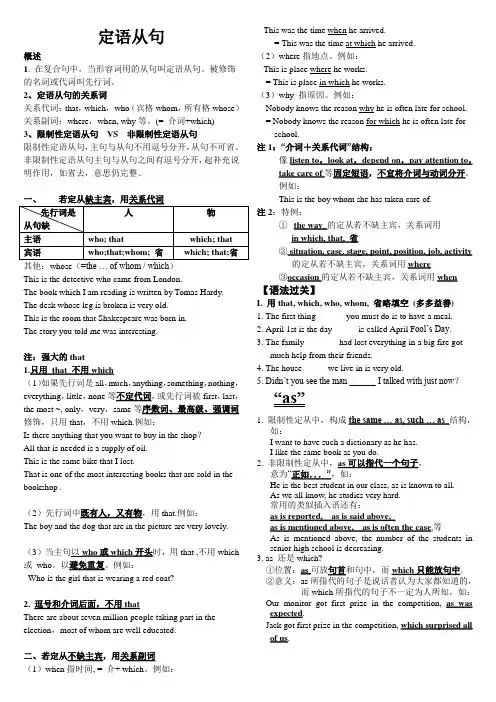
定语从句概述1. 在复合句中,当形容词用的从句叫定语从句。
被修饰的名词或代词叫先行词。
2、定语从句的关系词关系代词:that,which, who(宾格whom,所有格whose)关系副词:where,when, why等。
(= 介词+which)3、限制性定语从句VS 非限制性定语从句限制性定语从句,主句与从句不用逗号分开,从句不可省。
非限制性定语从句主句与从句之间有逗号分开,起补充说明作用,如省去,意思仍完整。
其他:whose(=the … of whom / which)This is the detective who came from London.The book which I am reading is written by Tomas Hardy. The desk whose leg is broken is very old.This is the room that Shakespeare was born in.The story you told me was interesting.注:强大的that1.只用that 不用which(1)如果先行词是all,much,anything,something,nothing,everything,little,none等不定代词,或先行词被first,last,the most ~, only,very,same等序数词、最高级、强调词修饰,只用that,不用which.例如:Is there anything that you want to buy in the shop?All that is needed is a supply of oil.This is the same bike that I lost.That is one of the most interesting books that are sold in the bookshop .(2)先行词中既有人,又有物,用that.例如:The boy and the dog that are in the picture are very lovely.(3)当主句以who或which开头时,用that ,不用which 或who。

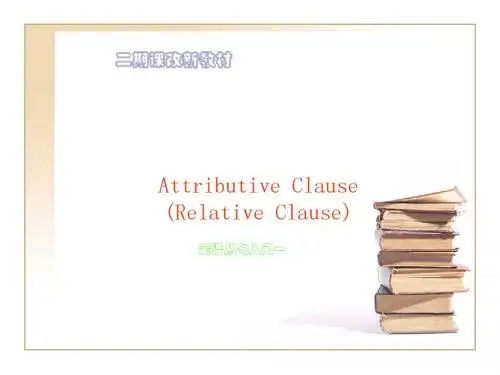
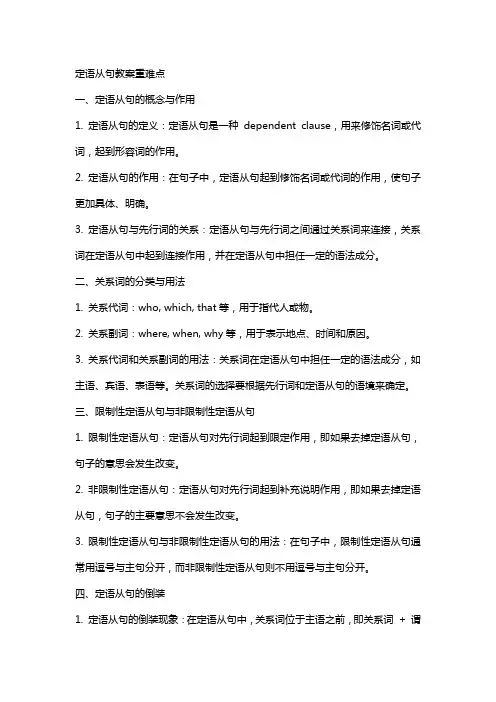
定语从句教案重难点一、定语从句的概念与作用1. 定语从句的定义:定语从句是一种dependent clause,用来修饰名词或代词,起到形容词的作用。
2. 定语从句的作用:在句子中,定语从句起到修饰名词或代词的作用,使句子更加具体、明确。
3. 定语从句与先行词的关系:定语从句与先行词之间通过关系词来连接,关系词在定语从句中起到连接作用,并在定语从句中担任一定的语法成分。
二、关系词的分类与用法1. 关系代词:who, which, that等,用于指代人或物。
2. 关系副词:where, when, why等,用于表示地点、时间和原因。
3. 关系代词和关系副词的用法:关系词在定语从句中担任一定的语法成分,如主语、宾语、表语等。
关系词的选择要根据先行词和定语从句的语境来确定。
三、限制性定语从句与非限制性定语从句1. 限制性定语从句:定语从句对先行词起到限定作用,即如果去掉定语从句,句子的意思会发生改变。
2. 非限制性定语从句:定语从句对先行词起到补充说明作用,即如果去掉定语从句,句子的主要意思不会发生改变。
3. 限制性定语从句与非限制性定语从句的用法:在句子中,限制性定语从句通常用逗号与主句分开,而非限制性定语从句则不用逗号与主句分开。
四、定语从句的倒装1. 定语从句的倒装现象:在定语从句中,关系词位于主语之前,即关系词+ 谓语+ 主语。
2. 定语从句倒装的用法:定语从句的倒装主要用于强调关系词或先行词,使句子更加突出。
3. 定语从句倒装的注意事项:并非所有的定语从句都需要倒装,要根据句子的语境和意义来判断是否需要倒装。
五、定语从句的练习与巩固1. 练习题:请根据先行词和语境,选择合适的关系词,并填入空格中。
2. 练习题:请将下列句子改为定语从句,并注意关系词的选择和倒装现象。
3. 练习题:请判断下列句子中的定语从句是限制性定语从句还是非限制性定语从句,并解释原因。
六、关系代词who的用法1. who的定义:who用于指代人,在定语从句中作主语或宾语。
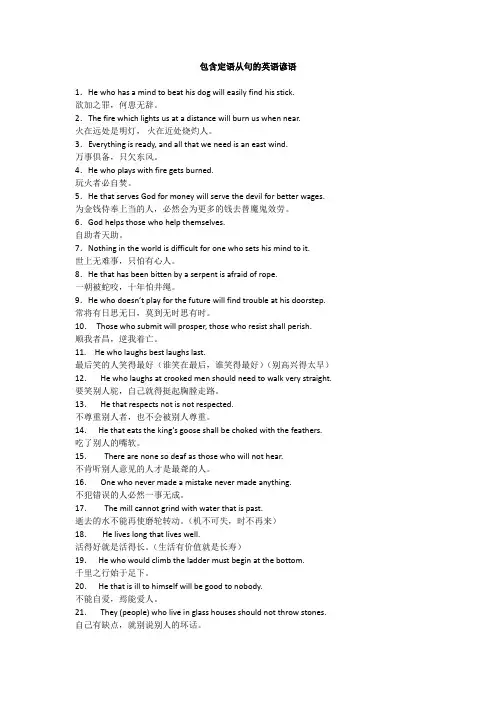
包含定语从句的英语谚语1.He who has a mind to beat his dog will easily find his stick.欲加之罪,何患无辞。
2.The fire which lights us at a distance will burn us when near. 火在远处是明灯,火在近处烧灼人。
3.Everything is ready, and all that we need is an east wind.万事俱备,只欠东风。
4.He who plays with fire gets burned.玩火者必自焚。
5.He that serves God for money will serve the devil for better wages.为金钱侍奉上当的人,必然会为更多的钱去替魔鬼效劳。
6.God helps those who help themselves.自助者天助。
7.Nothing in the world is difficult for one who sets his mind to it.世上无难事,只怕有心人。
8.He that has been bitten by a serpent is afraid of rope.一朝被蛇咬,十年怕井绳。
9.He who doesn’t play for the future will find trouble at his doorstep.常将有日思无日,莫到无时思有时。
10. Those who submit will prosper, those who resist shall perish.顺我者昌,逆我着亡。
11. He who laughs best laughs last.最后笑的人笑得最好(谁笑在最后,谁笑得最好)(别高兴得太早)12. He who laughs at crooked men should need to walk very straight.要笑别人驼,自己就得挺起胸膛走路。
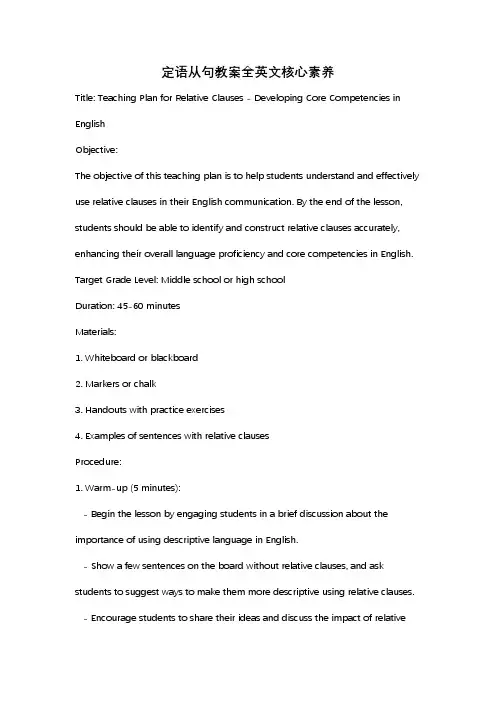
定语从句教案全英文核心素养Title: Teaching Plan for Relative Clauses - Developing Core Competencies in EnglishObjective:The objective of this teaching plan is to help students understand and effectively use relative clauses in their English communication. By the end of the lesson, students should be able to identify and construct relative clauses accurately, enhancing their overall language proficiency and core competencies in English. Target Grade Level: Middle school or high schoolDuration: 45-60 minutesMaterials:1. Whiteboard or blackboard2. Markers or chalk3. Handouts with practice exercises4. Examples of sentences with relative clausesProcedure:1. Warm-up (5 minutes):- Begin the lesson by engaging students in a brief discussion about the importance of using descriptive language in English.- Show a few sentences on the board without relative clauses, and ask students to suggest ways to make them more descriptive using relative clauses. - Encourage students to share their ideas and discuss the impact of relativeclauses on sentence structure and meaning.2. Introduction to Relative Clauses (10 minutes):- Introduce the concept of relative clauses by explaining that they provide additional information about a noun in a sentence.- Present a clear definition of relative clauses, emphasizing their role in creating complex sentences.- Provide examples of sentences with relative clauses and explain how they modify the noun in each sentence.- Highlight the use of relative pronouns (e.g., who, whom, whose, which, that) and relative adverbs (e.g., when, where, why) in forming relative clauses.3. Types of Relative Clauses (10 minutes):- Explain the two types of relative clauses: defining and non-defining.- Differentiate between the two types by illustrating their usage and punctuation rules.- Provide examples of each type and discuss their impact on sentence meaning and structure.- Emphasize the use of commas for non-defining relative clauses and their absence for defining relative clauses.4. Practice Exercises (15 minutes):- Distribute handouts with practice exercises involving relative clauses.- Include a mix of sentence completion, sentence transformation, and sentence identification tasks.- Encourage students to work individually or in pairs to complete the exercises. - Monitor their progress and provide assistance when needed.5. Group Discussion and Application (10 minutes):- Facilitate a group discussion to review the answers to the practice exercises. - Encourage students to explain their reasoning and discuss any challenges they encountered.- Provide additional examples and guide students in applying relative clauses to create more descriptive sentences.- Engage students in a short speaking activity where they use relative clauses to describe people, places, or objects.6. Conclusion and Wrap-up (5 minutes):- Summarize the key points covered in the lesson, emphasizing the importance of relative clauses in enhancing English language proficiency.- Address any remaining questions or concerns from students.- Assign homework that involves creating sentences with relative clauses.- Conclude the lesson by expressing confidence in students' ability to utilize relative clauses effectively.Note: This teaching plan can be adapted and modified based on the specific needs and proficiency level of the students.。
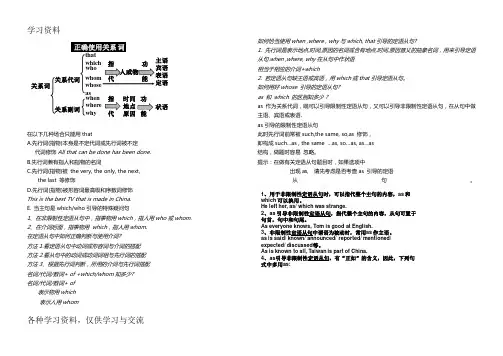
各种学习资料,仅供学习与交流关系词关系副词that which whomwhose aswhen why whowhere正确使用关系词主语宾语表语定语状语指功时间地点原因功在以下几种场合只能用thatA.先行词(指物)本身是不定代词或先行词被不定 代词修饰All that can be done has been done.B.先行词兼有指人和指物的名词C.先行词(指物)被 the very, the only, the next, the last 等修饰D.先行词(指物)被形容词最高级和序数词修饰This is the best TV that is made in China.E. 当主句是which/who 引导的特殊疑问句1、在非限制性定语从句中,指事物用which ,指人用who 或whom.2、在介词后面,指事物用 which ,指人用whom. 在定语从句中如何正确判断与使用介词? 方法1.看定语从句中动词或形容词与介词的搭配 方法2.看从句中的动词或动词词组与先行词的搭配 方法3、根据先行词判断,所用的介词与先行词搭配 名词/代词/数词+ of +which/whom 知多少? 名词/代词/数词+ of 表示物用which表示人用whom如何恰当使用when ,where , why 与which, that 引导的定语从句?1. 先行词是表示地点,时间,原因的名词或含有地点,时间,原因意义的抽象名词,用来引导定语从句.when ,where, why 在从句中作状语 相当于相应的介词+which2. 若定语从句缺主语或宾语,用which 或that 引导定语从句。
如何用好whose 引导的定语从句? as 和 which 的区别知多少?as 作为关系代词,既可以引导限制性定语从句,又可以引导非限制性定语从句,在从句中做主语、宾语或表语.as 引导的限制性定语从句此时先行词前常被such,the same, so,as 修饰, 即构成such …as , the same …as, so …as, as …as 结构,做题时容易 忽略。
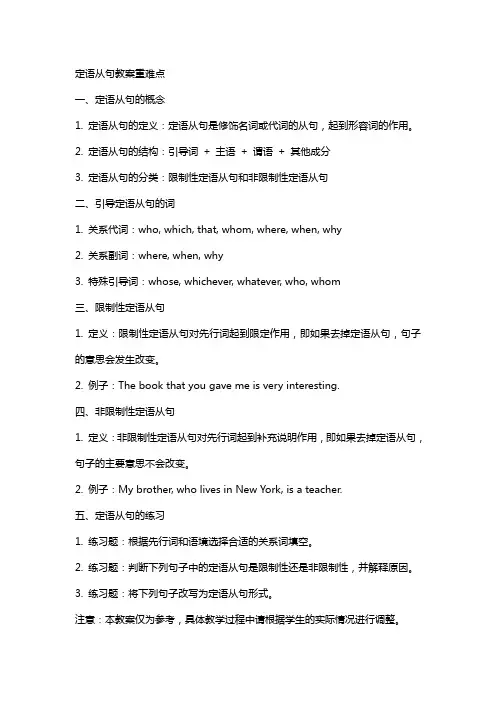
定语从句教案重难点一、定语从句的概念1. 定语从句的定义:定语从句是修饰名词或代词的从句,起到形容词的作用。
2. 定语从句的结构:引导词+ 主语+ 谓语+ 其他成分3. 定语从句的分类:限制性定语从句和非限制性定语从句二、引导定语从句的词1. 关系代词:who, which, that, whom, where, when, why2. 关系副词:where, when, why3. 特殊引导词:whose, whichever, whatever, who, whom三、限制性定语从句1. 定义:限制性定语从句对先行词起到限定作用,即如果去掉定语从句,句子的意思会发生改变。
2. 例子:The book that you gave me is very interesting.四、非限制性定语从句1. 定义:非限制性定语从句对先行词起到补充说明作用,即如果去掉定语从句,句子的主要意思不会改变。
2. 例子:My brother, who lives in New York, is a teacher.五、定语从句的练习1. 练习题:根据先行词和语境选择合适的关系词填空。
2. 练习题:判断下列句子中的定语从句是限制性还是非限制性,并解释原因。
3. 练习题:将下列句子改写为定语从句形式。
注意:本教案仅为参考,具体教学过程中请根据学生的实际情况进行调整。
六、关系代词who, which, that的用法辨析1. who:用于指人,作主语或宾语。
例子:The woman who is speaking to you is my mother.2. which:用于指物,作主语或宾语。
例子:The book which you gave me is very interesting.3. that:既可以指人,也可以指物,作主语或宾语。
例子:The man that you saw yesterday is my uncle.七、关系副词where, when, why的用法1. where:指地点,作状语。
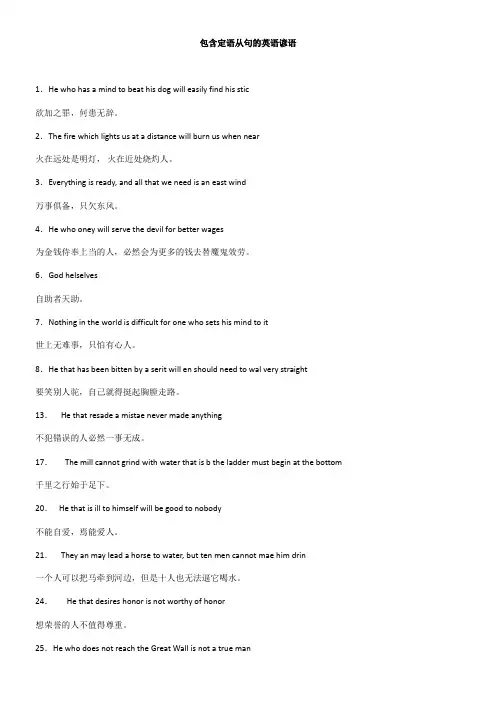
包含定语从句的英语谚语1.He who has a mind to beat his dog will easily find his stic欲加之罪,何患无辞。
2.The fire which lights us at a distance will burn us when near火在远处是明灯,火在近处烧灼人。
3.Everything is ready, and all that we need is an east wind万事俱备,只欠东风。
4.He who oney will serve the devil for better wages为金钱侍奉上当的人,必然会为更多的钱去替魔鬼效劳。
6.God helselves自助者天助。
7.Nothing in the world is difficult for one who sets his mind to it世上无难事,只怕有心人。
8.He that has been bitten by a serit will en should need to wal very straight要笑别人驼,自己就得挺起胸膛走路。
13.He that resade a mistae never made anything不犯错误的人必然一事无成。
17.The mill cannot grind with water that is b the ladder must begin at the bottom 千里之行始于足下。
20.He that is ill to himself will be good to nobody不能自爱,焉能爱人。
21.They an may lead a horse to water, but ten men cannot mae him drin一个人可以把马牵到河边,但是十人也无法逼它喝水。
24.He that desires honor is not worthy of honor想荣誉的人不值得尊重。
《定语从句》英语谚
语
包含定语从句的英语谚语
1.He who has a mind to beat his dog will easily find his stick.
欲加之罪,何患无辞。
2.The fire which lights us at a distance will burn us when near. 火在远处是明灯,火在近处烧灼人。
3.Everything is ready, and all that we need is an east wind.
万事俱备,只欠东风。
4.He who plays with fire gets burned.
玩火者必自焚。
5.He that serves God for money will serve the devil for better wages.
为金钱侍奉上当的人,必然会为更多的钱去替魔鬼效劳。
6.God helps those who help themselves.
自助者天助。
7.Nothing in the world is difficult for one who sets his mind to it.
世上无难事,只怕有心人。
8.He that has been bitten by a serpent is afraid of rope.
一朝被蛇咬,十年怕井绳。
9.He who doesn’t play for the future will find trouble at his doorstep.
常将有日思无日,莫到无时思有时。
10. Those who submit will prosper, those who resist shall perish.
顺我者昌,逆我着亡。
11. He who laughs best laughs last.
最后笑的人笑得最好(谁笑在最后,谁笑得最好)(别高兴得太早)
12. He who laughs at crooked men should need to walk very straight.
要笑别人驼,自己就得挺起胸膛走路。
13. He that respects not is not respected.
不尊重别人者,也不会被别人尊重。
14. He that eats the king’s goose shall be choked with the feathers.
吃了别人的嘴软。
15. There are none so deaf as those who will not hear.
不肯听别人意见的人才是最聋的人。
16. One who never made a mistake never made anything.
不犯错误的人必然一事无成。
17. The mill cannot grind with water that is past.
逝去的水不能再使磨轮转动。
(机不可失,时不再来)
18. He lives long that lives well.
活得好就是活得长。
(生活有价值就是长寿)
19. He who would climb the ladder must begin at the bottom.
千里之行始于足下。
20. He that is ill to himself will be good to nobody.
不能自爱,焉能爱人。
21. They (people) who live in glass houses should not throw stones.
自己有缺点,就别说别人的坏话。
22. They that reckon without their host are to reckon twice.
店主不在便结账,还得再结第二遍。
23. One man may lead a horse to water, but ten men cannot make him drink. 一个人可以把马牵到河边,但是十人也无法逼它喝水。
24. He that desires honor is not worthy of honor.
想荣誉的人不值得尊重。
25.He who does not reach the Great Wall is not a true man.
不到长城非好汉。
26. He who laughs last laughs best.
谁笑到最后,谁笑得最好。
27. All is well that ends well.
结局好,一切都好。
28. All that glitters is not gold.
闪闪发光的不都是金子。
29. The hands that push cradles are the hands that push the world.
推动摇篮的手,就是推动世界的手。
30.He who knows others is learned, and he who knows himself is wise.
知人者智,自知者明。
31. He who loves others is constantly loved, and he who respects others is constantly respected.
爱人者人恒爱之,敬人者恒敬之。
32. True friendship is like sound health, the value of which is seldom known until it is lost.
真正的友情就像健康一样,只有当失去时,才会意识到它的价值。